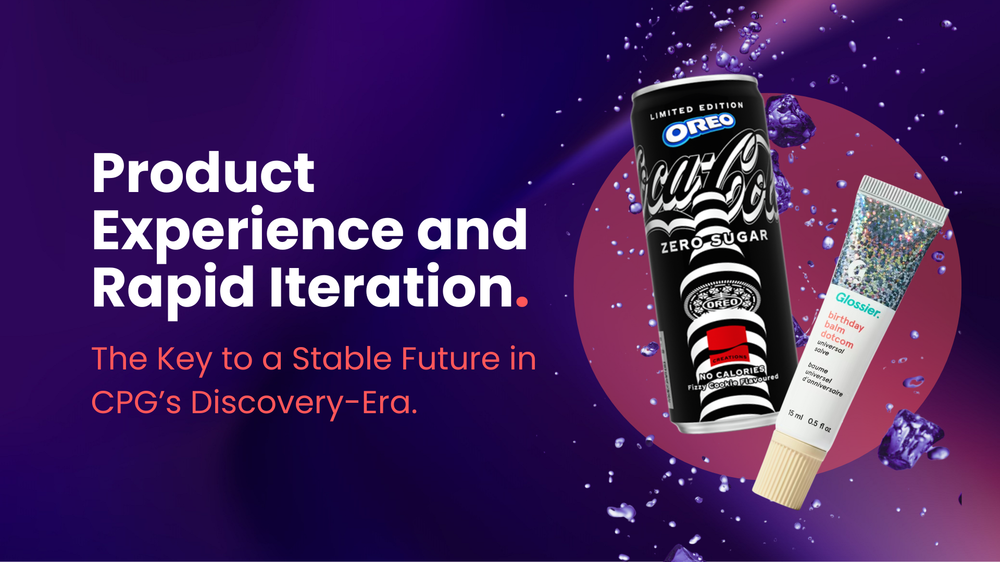Product Experience and Rapid Iteration
The consumer packaged goods (CPG) industry is facing a whirlwind of challenges in today’s volatile market. With fluctuating consumer demands, increased competition, and the need to innovate quickly, companies are struggling to maintain stability.

Market instability, driven by inflation, economic uncertainty, and shifting consumer behavior, is forcing CPGs to adapt quickly. The “discovery era,” where consumers are constantly exploring new products and brands, has led to a decline in brand loyalty, creating further pressure on established players. Consumers today are more demanding, seeking products that are not only high-quality but also deliver sustainable, personalized, and innovative product experiences.
Increased CPG competition from agile startups and direct-to-consumer (D2C) brands is intensifying the struggle. These new entrants can react to trends faster, disrupt pricing models, and meet niche market needs more effectively than large global companies with traditional, slower product development cycles. More on that later.
Staying Relevant in the Fast-Paced CPG Market
To stay relevant, brands must innovate faster and more frequently. As consumer preferences shift in real-time, companies are under pressure to not only develop new products but also to rethink supply chains, leverage data analytics, and anticipate emerging trends within the CPG market. This need for speed is driven by consumer demands for convenience, sustainability and personalized experiences. However, the accelerated pace of innovation often strains resources and stretches operational limits, making it challenging for even the largest, most established companies to consistently deliver new and successful products.

The changing nature of product innovation demands an overhaul of traditional research & development (R&D) models. Nestlé, for example, has been focusing on shortening product development cycles through initiatives like their R&D Accelerator Network, which aim to bring new products to market in less than six months. This shift towards rapid innovation is vital, as CEO Mark Schneider remarked, “We are constantly evolving our product portfolio to respond to emerging consumer trends and stay ahead of competition.” However, this speed of innovation is not without its challenges. It requires significant investments in research and development, and companies must be agile enough to pivot quickly based on consumer feedback.
Adapt, Create, Iterate.
Adapting to Consumer Trends: CPG Innovation and Iteration

A major factor driving this shift in CPG R&D is the explosion of direct-to-consumer (D2C) brands that have disrupted the market by being nimbler in addressing specific consumer needs. For instance, D2C skincare brand Glossier has been able to outpace traditional beauty giants by leveraging social media and direct customer feedback to iterate products quickly. This level of agility is challenging for larger CPG companies with more complex supply chains and longer product testing cycles. According to a McKinsey report, "The challenge for FMCG incumbents is that startups are winning market share by bringing innovations to market faster, at a time when traditional approaches to R&D are not built for the same speed."
The pandemic further accelerated this trend, as brands had to quickly adapt to disruptions in supply chains and changes in consumer behavior. To keep up with the competitive CPG landscape, Procter & Gamble (P&G) enhanced its supply chain innovation strategies and launched new hygiene-related products in response to heightened consumer demand for cleanliness and safety. P&G’s CFO, Jon Moeller, emphasized that “the ability to innovate and deliver products at speed is now a key differentiator in CPG, and those who fail to adapt quickly will fall behind.” P&G’s focus on agility has helped it maintain its competitive edge, but the company has also had to manage the strain on resources, as ramping up production often quickly leads to increased costs and operational stress.

To cope with these demands, CPG companies are increasingly turning to data analytics and AI-driven insights to make smarter product decisions faster. Coca-Cola has been making use of AI to predict trends in real-time, allowing them to introduce new flavors and products, such as their limited-edition “Creations” series, which was launched based on digital data trends. While this approach helps identify and respond to shifting consumer preferences, it also adds pressure to ensure that innovation pipelines are agile and responsive enough to bring these insights to life before competitors do.
That said, the pressure to innovate quickly is not just about speed—it’s also about maintaining quality and sustainability. Consumers are looking for new products and demanding environmentally friendly and ethically sourced options. Unilever, for instance, has made significant strides in transforming its supply chain to meet these demands, but as CEO Alan Jope mentioned, “Sustainable innovation requires even more resources and commitment, making it a complex challenge for large FMCG companies.”
So where does this all net out?
Key Takeaways for CPG Companies Facing Market Volatility
CPGs must innovate faster to remain competitive in a dynamic marketplace, but the speed and agility required often pushes resources and operational capacities to their limits. The key to overcoming these challenges lies in rethinking traditional innovation models and research techniques, integrating real-time data analytics, and building more agile and resilient supply chains. Those that can balance speed with sustainability, while managing the strain on resources, will be best positioned to thrive in this new era of CPG innovation.